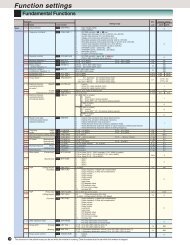You also want an ePaper? Increase the reach of your titles
YUMPU automatically turns print PDFs into web optimized ePapers that Google loves.
C C<br />
Figure 5 Electrostatic Noise<br />
(3) Radiation noise<br />
Noise generated in the inverter is radiated through the air from antennas consisting of wires at the<br />
input and output sides of the inverter. This noise is radiation noise 5) (Figure 6). The antennas that<br />
emit radiation noise are not limited only to wires, the motor frame and panel containing the inverter<br />
may also act as antennas.<br />
Figure 6 Radiation Noise<br />
3 Noise Prevention Measures<br />
As noise prevention measures are strengthened, they become more effective. With the use of appropriate<br />
measures, noise problems may be resolved simply. Therefore, it is necessary to implement economical<br />
noise prevention measures according to the noise level and the equipment condition.<br />
3.1 Noise Prevention Treatments Prior to Installation<br />
Before inserting an inverter in a control panel or installing an inverter panel, it is necessary to consider the<br />
noise. Once noise problems occur, great expenditures of apparatuses, materials and time are required.<br />
Noise prevention treatments prior to installation are listed below.<br />
1) Separation of the wiring of the main circuit and control circuit<br />
2) Insertion of the main circuit wiring into a metal pipe (conduit pipe)<br />
3) Use of shielded wire or twisted shielded wire in the control circuit.<br />
4) Implementation of appropriate grounding work and grounding wiring.<br />
These treatments can avoid most noise problems.<br />
15-4



